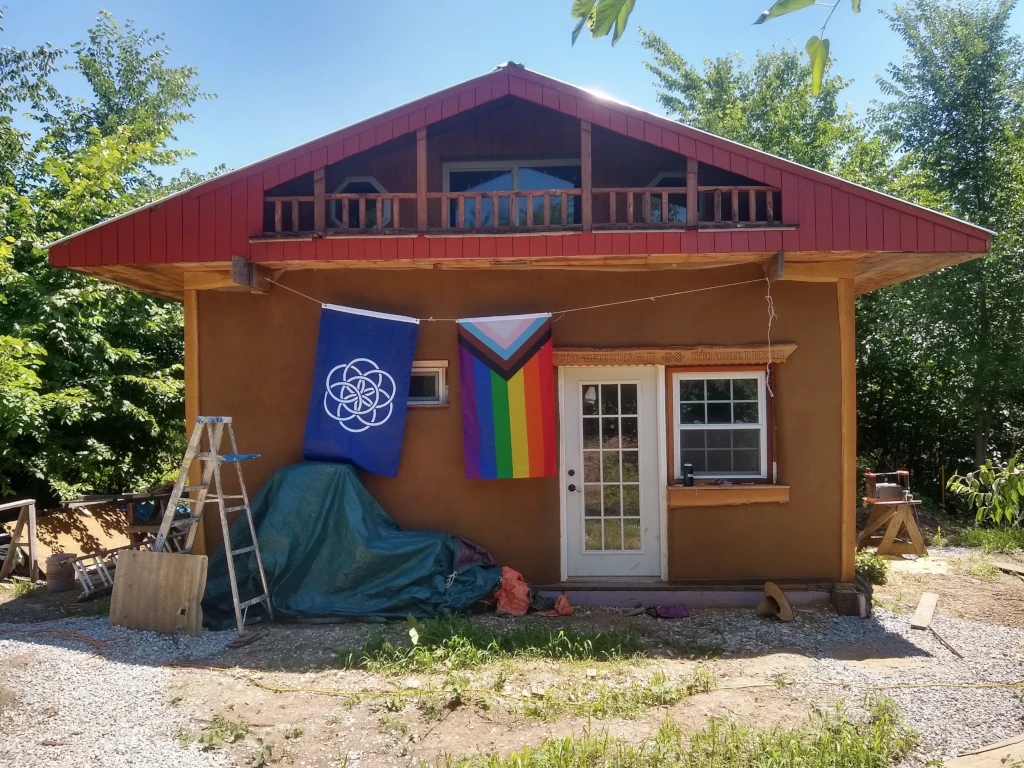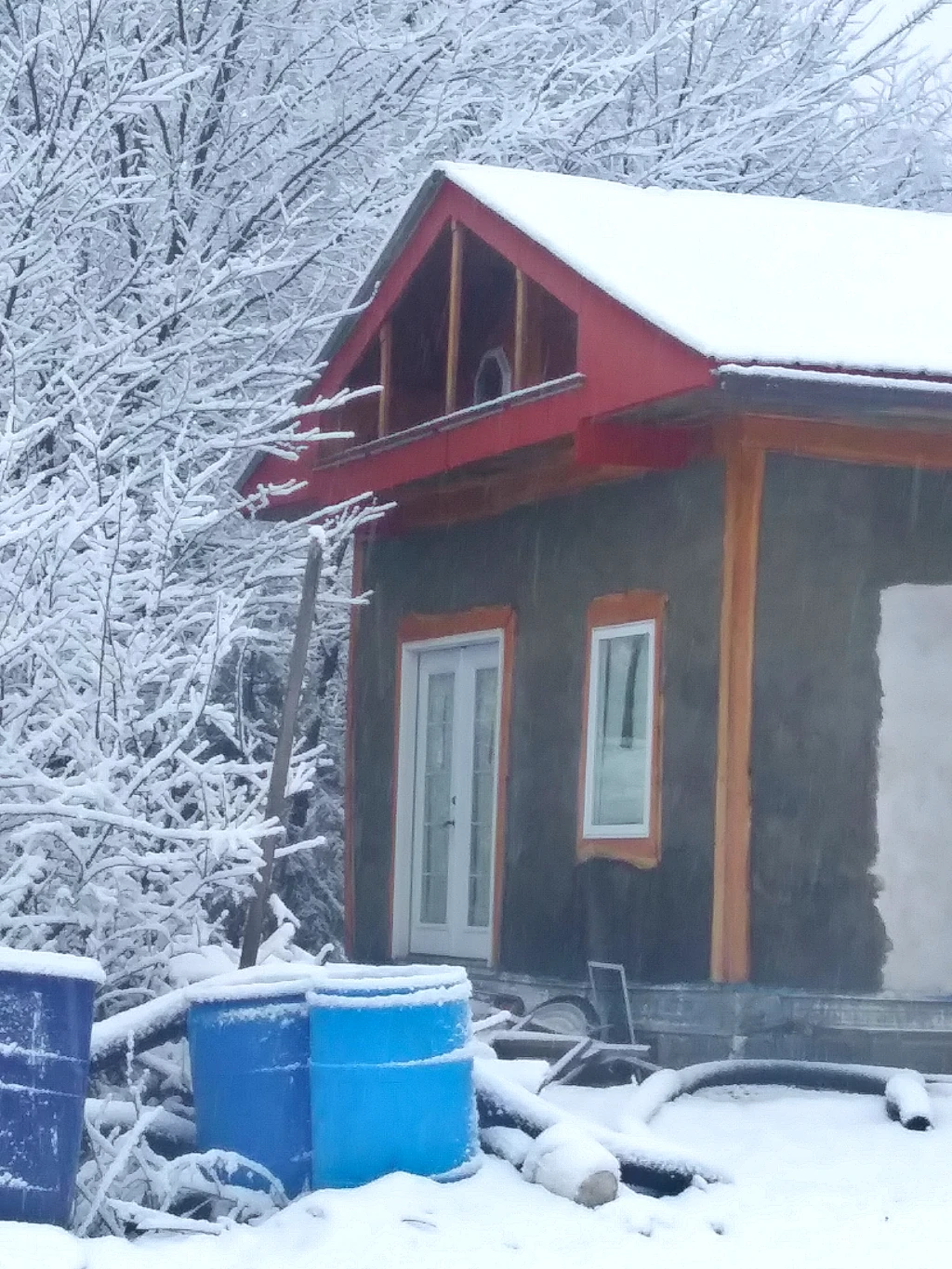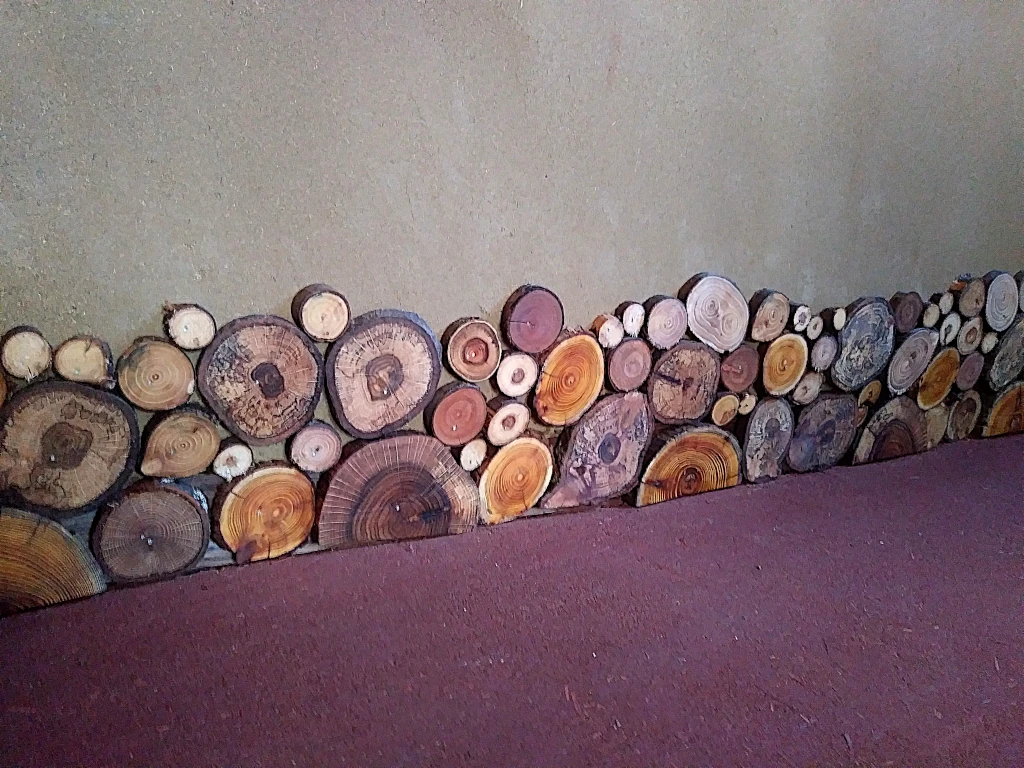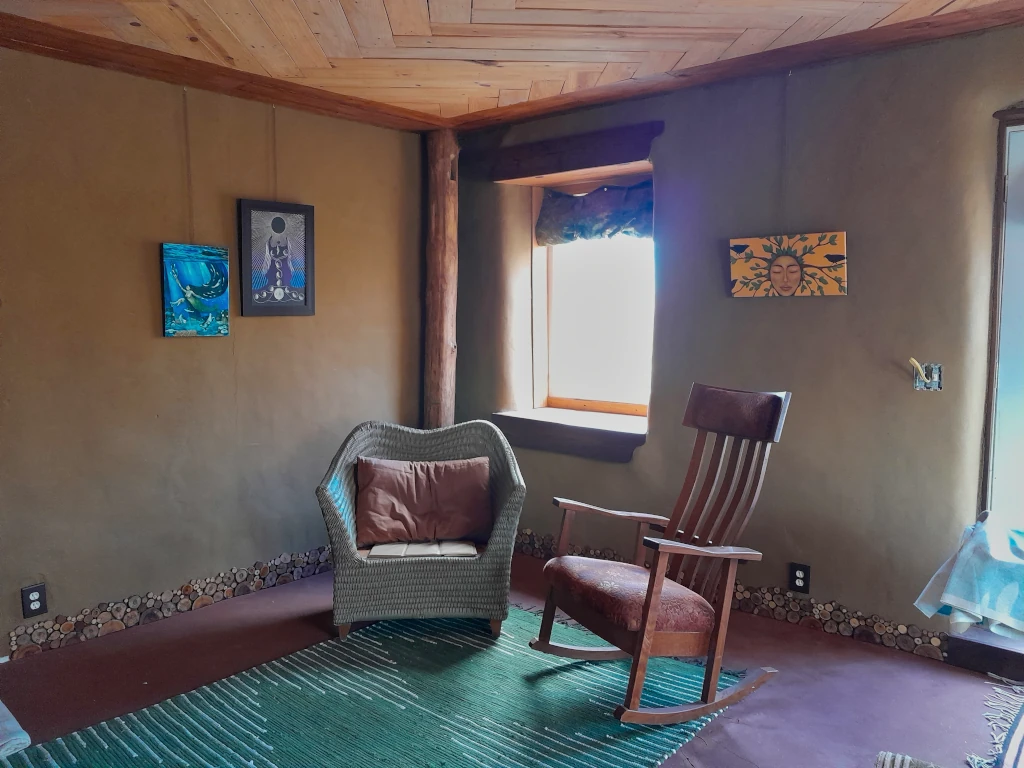Making Room for a Creative Life: A Dancing Rabbit Update
Published: Tue, 03/28/23

Making Room for a Creative Life:
A Dancing Rabbit Update
A common question I get about my building project is: when will it be done? I want to explain my answer to this, as it speaks to an approach to life that I am cultivating here at Dancing Rabbit, and because I rarely have the time to answer this in full. Liz here, to explain why this question irks me.
My son and I host visitor tours of the strawbale building project we call SubHub, mostly between April and October. I am asked mostly the same questions, and over time, I mostly give the same answers. When I say I’ve been working with a crew averaging about five people (one year we had 10 people), along with some short term volunteers, on this building for three years, some people gasp, or say wow! Or some such. We’re coming up on the start of the visitor season and now I get to say that we’ve been working on the project for four years.
I am reminded by these reactions how much our modern culture values productivity and accomplishment over following the ups and downs of inspiration, over the personal energies each person has in each season (hot, humid summers working outside, and cold, windy winters working inside), over working with people who have (often) unpaid community work that they do (committees, Common House clean team, rotating community chores like humey duty and stocking the CH with firewood year round), and co-op kitchen cook shifts each week, in addition to their daily life tasks.
There is also a longer timeline when using reclaimed materials (finding them, processing them) and a slower timeline for workers who are mostly learning how to do things for the first time. These two aspects are always looked at as obstacles to a project like this, and I want to rebut (to my imagined detractors) that these things are valuable, especially if they are the whole point of the project. If you build, you know of the money versus time versus quality trifecta; you can spend more money and get something done faster by hiring more workers, but it’s more expensive. If you are trying to get something done faster, you often have to sacrifice quality, creativity or customization. Creativity often requires time; time to mull things over, time to try several methods or materials until you get the result that you are imagining, and more time to create it.
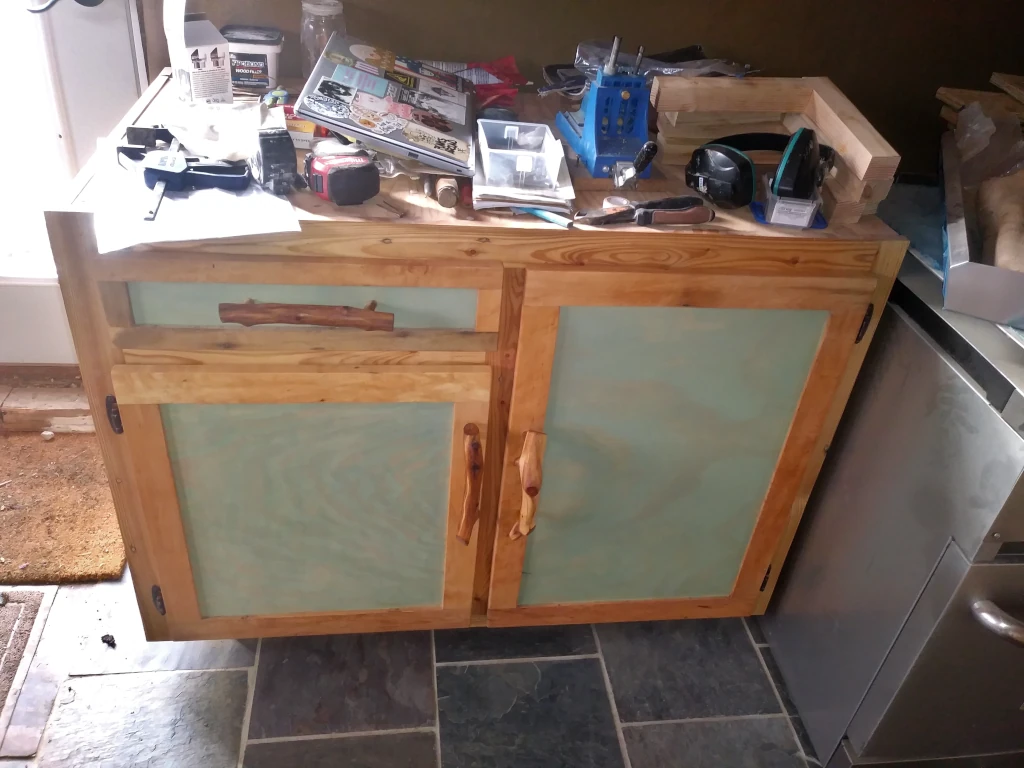
Custom kitchen cabinets that Graham and Prairie built, with Osage orange wood handles. Photo by Liz.
Urban people, including myself, often lack practical building skills. We are convinced that things like plumbing, electrical, framing, cabinetry, woodworking, installing windows and doors, and digging and filling trenches are best left to experts who have a lot of experience doing these things, and can do them well, and fast. So to many, the very premise of my project, which is hiring amateurs to build a building from the ground up using natural and reclaimed materials when possible, is just folly. That the project has continued moving forward over a period of years is a miracle. That mostly women built it, unbelievable.
As I mentally struggle to throw off the influence of people outside of the project who clearly have a preference for me finishing this project, and are clearly using a yardstick used for measuring conventional construction projects (a very, very different thing), I remind myself (almost daily) of what my aim is. This will be the only building project that I work on, where there is no client waiting to start living in the finished building. This will be the only project, for my entire life, where I can fully implement my design ideas, and have full rein over materials, colors, quality and creativity. If I rush to finish, or focus on saving money over the time it takes to master building skills and create a beautiful, natural interior mostly from scratch, I will have a very different result, and a very different personal experience.
And this is where living at Dancing Rabbit has influenced me in my approach to the project. If we want a more personal experience of life, we have to have the time to do that. If our work life requires that we sacrifice time for personal conversations, personal free time, time for helping friends in crisis, time for having fun, or mulling over what we want out of life, then we’ll have a very different outcome looking back on our life overall.
We’ve had a few community experts and Very Productive People come to DR and wonder why we don’t get more done in the village, and why we don’t work longer hours to make more money (something in short supply around here). Why, if we just put our shoulders to the wheel, think what we could accomplish! I wondered that myself, when I first moved here. Over time, I came to realize how much time it takes to keep this place humming on an organizational level, how much time it takes to cultivate relationships with people here, and how much time it takes to just participate in community activities and events here (and I’m not even one of the gung ho socializers!) These are aspects of life that are highly valued by most Rabbits at DR.
Questions that would cultivate more interesting conversations with me would be to ask me how things are going on the project, what we’re currently working on, what interesting challenges we’re facing right now, or what solutions we’ve come up with recently that are particularly satisfying.
So much of what I’m thinking about right now is off the grid of a typical construction project, which is exactly the point. An example would be the thought process of creating a baseboard for the living room. At first I imagined a baseboard made of pebbles. After researching it, I found it was too expensive. Then we conceived of the living room as a forest room, so we thought that a mosaic tile baseboard that evoked a forest floor, with green and brown tiles, would look great. That too, was too expensive. After looking at many cordwood floor designs, I was inspired to use cordwood for the baseboard. K* and Graham and I sliced tree branches of various species and diameters collected from around the village into wafers. Squirrel and I put borax and tung oil on each wafer, and then I attached them in slightly random patterns to the base of the wall with a nail gun to form the baseboard. Voila! Gorgeous! If my priority was saving time and money, I could have simply bought a piece of wood molding used for baseboards and, within an afternoon, nailed it to the base of the walls. Come by and take a look and tell me it wasn’t worth doing!
The last point I want to make is the service aspect of this project. My son, Graham, and I conceived of this building as a place for people to gather, to cross pollinate ideas, to start other service projects and to provide additional living spaces for wexers (work exchangers). As we started our third year of building, I realized I didn’t need to wait until the building was finished to start building our subcommunity. I decided to start hiring and training women to see if I could provide some jobs to the community and to raise the bar on DR’s commitment to gender equity. And many women have come out of the woodwork (pun intended) to work on this building! Launching part of the building’s mission before finishing it has certainly added time to the project, but adding women builders into the mix is helping me finish the project.
So the crew and I come to work on the project and we try to get as much done as we can. And sometimes we sit and talk about things in our lives, and we don’t get much building done, but relationships get built. Sometimes we spend more time brainstorming and figuring out how we want to do something. Sometimes not much is said, and hard grueling work (like shoveling gravel into trenches, or applying plaster) gets done. It is my opinion that including personal needs and schedules in the making of something as complex as a building builds resilience for actually finishing it, and that adds time that is well worth it.
Not having a hard deadline for finishing SubHub doesn’t mean we won’t finish it. It does mean, however, that when we arrive at that point, we’ll have gotten there with all of our values intact, with a unique building to show for it, and hopefully with many more people in our village who have the skills for natural building projects.
 |
Liz Hackney is the editor of this newsletter. A premiere ticket to DR’s Open House on Saturday, May 13th, from 10-3pm, includes tours of many of DR’s natural buildings, including SubHub. See you there! For tickets, go to www.dancingrabbit.org/oh |
If you’re curious about natural building, consider taking our cob oven workshop in early August. You'll be able to experience the natural buildings in the village! More information can be found on our website: www.dancingrabbit.org.
Dancing Rabbit Ecovillage, 1 Dancing Rabbit Lane, Rutledge, MO 63563, USA
Unsubscribe | Change Subscriber Options
